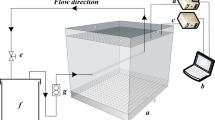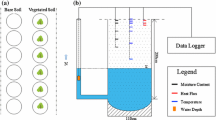Abstract
Soil heat flux is one of the important components of surface energy balance. In this study, long-term estimation of soil heat flux from single layer soil temperature was carried out by the traditional sinusoidal analytical method and the half-order time derivative method of Wang and Bras [Wang and Bras (1999) J Hydrol 216:214–226]. In order to understand the characteristics of soil heat flux and to examine the performances of the two methods, a field experiment was conducted at a temperate and humid grassland in Cork, Ireland. Our results show that the soil heat flux had the same magnitude as the sensible heat flux at this grassland site. It was also demonstrated that the analytical method did not predict the soil heat flux well because the sinusoidal assumption for the temporal variation in soil heat flux was invalid. In contrast, good agreement was found between the soil heat flux measurements and predictions made by the half-order time derivative method. This success suggests that this method could be used to estimate soil heat flux from long-term remotely sensed surface temperature.










Similar content being viewed by others
References
Campbell GS, Norman JM (1998) An introduction to environmental biophysics. Bartlett, Marietta, GA, p 286
Carslaw HS, Jaeger JC (1986) Conduction of heat in solids. Clarendon, Oxford, p 510
Clothier BE, Clawson KL, Pinter PJ Jr., Moran MS, Reginato RJ, Jackson RD (1986) Estimation of soil heat flux from radiation during the growth of alfalfa. Agric For Meteorol 37:319–329
Idso SB, Aase JK, Jackson RD (1975) Net radiation–soil heat flux relations as influenced by water content variations. Boundary Layer Meteorol 9:113–122
Kimball BA, Jackson RD (1975) Soil heat-flux determination: a null-alignment method. Agric For Meteorol 15:1–9
Kustas WP, Daughtry CST (1990) Estimation of the soil heat flux/net radiation ratio from spectral data. Agric For Meteorol 49:205–223
Malek E (1993) Rapid changes of the surface soil heat flux and its effects on the estimation of evapo-transpiration. J Hydrol 142:89–97
Miller KS, Ross B (1993) An introduction to the fractional calculus and fractional differential equations. Wiley, New York
Ogee J, Lamaud E, Brunet Y Berbigier P, Bonnefond JM (2001) A long-term study of soil heat flux under a forest canopy. Agric For Meteorol 106:173–186
Stull RB (1988) An introduction to boundary layer meteorology. Kluwer, Dordrecht, p 666
Wang J, Bras RL (1999) Ground heat flux estimated from surface soil temperature. J Hydrol 216:214–226
Zhang HF, Ge XS, Ye H, Jiao DS (2007) Heat conduction and heat storage characteristics of soils. Appl Thermal Eng 27:369–373
Acknowledgements
The authors would like to thank the two anonymous reviewers for their helpful comments. C.-I.H. and C.-W.H. thank the National Science Council, Taiwan for their support of this study. G.K. acknowledges support from the ERTDI program managed by the Irish Environmental Protection Agency and funded by the Irish Government under the National Development Plan, 2000–2006 (CELTICFLUX, 2001-CC-C2-M1).
Author information
Authors and Affiliations
Corresponding author
Appendix: Derivation of the half-order time derivative method
Appendix: Derivation of the half-order time derivative method
The algorithm and derivation of the half-order time derivative method was first proposed by Wang and Bras (1999). Here, details of the derivation are provided.
First of all, define two new variables: \(\tilde z = {z \mathord{\left/ {\vphantom {z {\sqrt {D_0 } }}} \right. \kern-\nulldelimiterspace} {\sqrt {D_0 } }}\) and \(\Theta = T - T_0 \), and then transfer Eqs. 7, 9, and 10 to:
Now, take the Laplace transform of both sides of Eq. A1. According to the definition of Laplace transform, \(L\left\{ {\frac{\partial }{{\partial t}}f\left( t \right)} \right\}\left( s \right) = sF\left( s \right) - f\left( 0 \right)\), the left hand side of A1 then becomes \(s\tilde \Theta \left( {\tilde z,s} \right) - \Theta \left( {\tilde z,0} \right) = s\tilde \Theta \left( {\tilde z,s} \right)\) since A2 requires \(\Theta \left( {\tilde z,0} \right) = 0\). The Laplace transform of the right hand side remains the same since the Laplace transform is based on the variable t. Hence, Eq. A1 is transformed to
where \(\tilde \Theta \) is the Laplace transform of \(\Theta \) and defined as:
The general solution of Eq. A4 is
where A(s) and B(s) are arbitrary functions of s and can be determined by the boundary conditions. By Eq. A3, B(s) is found to be zero and Eq. A6 then becomes:
Differentiating both sides of Eq. A7 with respect to \(\tilde z\) gives:
Now, substituting A7 into A8 yields
Based on the equation derived by the fractional calculus (Miller and Ross 1993),
the right hand side of Eq. A9 becomes
By the initial condition Eq. A2, the last term of Eq. A10, f(0), is found to be zero. Replacing the right hand side of Eq. A9 by Eq. A11, we have
Inverting the Laplace transform of Eq. A12 leads to
With the definition of Θ, Eq. A13 becomes
Now, applying the fractional calculus (Miller and Ross 1993)
to the right hand side of Eq. A14, we have
Finally, the prognostic result can be evaluated by applying Eq. A16 to Fourier’s law, and then we have
Equation A17 can also be written as:
And its discrete form is
where N is the number of intervals.
Rights and permissions
About this article
Cite this article
Hsieh, CI., Huang, CW. & Kiely, G. Long-term estimation of soil heat flux by single layer soil temperature. Int J Biometeorol 53, 113–123 (2009). https://doi.org/10.1007/s00484-008-0198-8
Received:
Revised:
Accepted:
Published:
Issue Date:
DOI: https://doi.org/10.1007/s00484-008-0198-8




